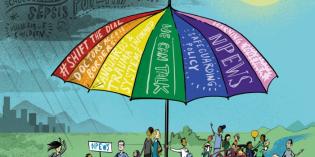All staff who come into contact with children and young people have a responsibility to safeguard and promote their welfare and should know what to do if they have concerns about safeguarding and child protection issues. All Trusts must have a named doctor and nurse for safeguarding, who will provide advice and expertise for fellow professionals and promote good practice within their organisation.
An essential component of the RCPCH mission is to make safeguarding the health and wellbeing of infants, children and young people at the core of all we do. To support our members to do this, we have developed a new safeguarding competencies framework specifically for paediatricians - download below.
This is complementary to the full intercollegiate competency framework that is for all healthcare staff, ranging from non-clinical staff to experts.
Paediatricians and paediatricians in training (Level 3 and 3+)
To protect children and young people from harm, and help improve their wellbeing, all paediatricians and paediatricians in training must have the competencies to recognise child maltreatment, opportunities to improve childhood wellbeing and to take effective action as appropriate to their role.
Over time the intercollegiate safeguarding competencies framework (known as the ICD) has evolved and become more complex. The RCPCH has therefore published this guide to ensure that our members fully understand the competencies that are required of them. This document complements the full ICD and correlates with the RCPCH Progress curriculum for trainees.
Competencies can be met by having the appropriate knowledge and skills, and in this document we have linked the knowledge and skills required for each competency. The ICD has defined learning outcomes which we have not reiterated in this document. Although we recommend that our members meet these standards, it is up to individual employers, health commissioners and the inspectorate to deliver and monitor them.
This document is for paediatricians and paediatricians in training only - download below. We recommend other professionals refer directly to the full document published by the Royal College of Nursing (RCN).
Named and Designated doctors (Level 4 and 5)
Named and designated doctors for child protection (England, Wales and NI) and the lead paediatrician for child protection / paediatrician with a special interest in child protection (Scotland) have additional responsibilities for safeguarding children.
We have summarised the competency frameworks for these roles exactly as they are presented in the intercollegiate competency framework, and presented them here in separate files, alongside the model job descriptions - download below.
All healthcare staff
We remain committed to the principle of having shared roles and competencies for safeguarding children applicable across the children’s workforce as this sets consistent high quality standards for healthcare workers and facilitates interdisciplinary working in order to achieve the best possible outcomes for children and young people.
The 4th edition of Safeguarding Children and Young People: Roles and Competencies for Healthcare Staff (also known as the ICD) can be found on the RCN website. Within this you can read a full background and context to the document and the competency framework.
The latest document has been updated to include changes to legislation and statutory guidance in England and now includes education and learning logs to enable individuals to record their learning and form a 'passport' for those who move on to new jobs or other organisations. Levels 1-3 relate to different occupational groups, while Levels 4 and 5 are related to specific roles. This version of the framework also includes specific detail for chief executives, chairs, board members including executives, non-executives and lay members.










